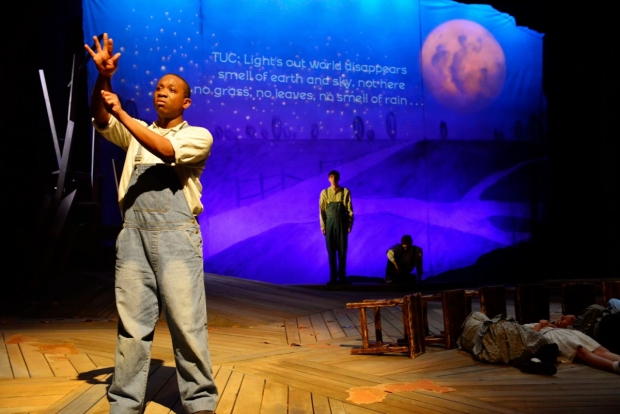The Taste of Sunrise and The Edge of Peace

(© Gary Ng)
Susan L. Zeder's Ware Trilogy was recently staged by a collaborative trio of Boston-based theaters, the first time all three plays have been produced together in one city. Tuc, the deaf and mute African-American man who is the trilogy's protagonist, anchors each of the plays. Elbert (E.J.) Joseph, who is deaf, played the leading role and delivered a sympathetic portrait of a boy who grows to manhood despite significant challenges.
The trilogy was presented in Boston over the past few months: Emerson Stage produced Mother Hicks in February, followed by The Taste of Sunrise, a prequel to the first play, at Wheelock Family Theatre, from March 13-22. The final work, The Edge of Peace, was staged at Central Square Theater from April 3-12. This review covers the second and third parts of the trilogy.
The plays' recurring characters include Tuc, the son of a farmer in the town; Nell Hicks, who is thought to be a witch because of her peculiar habits and self-imposed isolation from her neighbors; Girl, an orphan being raised by the townspeople; and Maisie, the hearing child of deaf parents. (Joseph, as Tuc, was the only performer cast in all three productions.) The first play, Mother Hicks, concerns Girl's adolescence when she is raised by Nell Hicks and befriended by Tuc.
The Taste of Sunrise, which takes place from 1917-1928, reaches back in time to Tuc's childhood. His father, a widower, is persuaded to send Tuc to a school away from home where he is to be trained in the prevailing ideology (for that time) of forcing deaf people to speak by forbidding the use of sign language. While Tuc is away from home, his father dies, leaving the boy an orphan. Maisie, whom he meets at the school, becomes his close friend. Students from the Horace Mann School for the Deaf and Hard of Hearing in Allston, Massachusetts, were cast along with Joseph and other young actors in the roles of the children at Tuc's school.
The Edge of Peace, takes place 10 years after the events in The Taste of Sunrise. Tuc has returned to Ware, where he earns his living doing odd jobs that allow him to use his natural gifts as a mechanic. One of the young men of the town has been lost in action in the war that informs most of the plot line. Nell Hicks, Girl, and Maisie are important characters in this play, along with Buddy Ricks, the 11-year-old brother of the missing soldier. Fifth grade actor David Sullivan turns in a remarkable performance as the inquisitive, hyperactive Buddy who will not accept being left out of the war effort.
The Ware Trilogy is presented in English and American Sign Language, augmented by Tuc's dialogue projected on the back wall of the set. Joseph signed conversations with other actors , including many of the children who appeared in the multigenerational casts. The signing formed a fascinating leitmotif of choreographed gestures that endowed the characters' relationships with a lyrical quality. Joseph's body postures, skillful stage movement, and eloquent facial expressions made his thoughts and reactions easy to understand. Janie E. Howland designed simple settings for the two productions. The setting for The Edge of Peace divided the stage in half, placing at stage left the Ware general store in the town center, complete with an upper story where Buddy hung out, and elevating Mother Hicks’ mountain top home at stage right to suggest the expanse of the rural surroundings.
Kristen Johnson and Wendy Lement, codirectors of The Taste of Sunrise, and Lee Mikeska Gardner and Maggie Moore Abdow, codirectors of The Edge of Peace, are to be commended for integrating the two languages into something more than a theatrical commentary on the condition of deafness. The Ware Trilogy can be favorably compared with the best works of young-adult literature, in providing both an educational exploration of an important subject as well as an engrossing story about how a young person grows up and takes charge of his own life, no matter the difficulties.










